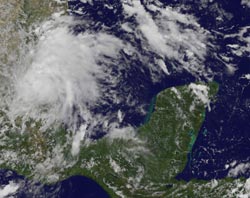Satellite Sees Atlantic Tropical Depression Eight Form in Southwestern Gulf of Mexico

NOAA's GOES-East satellite captured the birth of Tropical Depression Eight in the southwestern Gulf of Mexico at 2:31 p.m. EDT on Sept. 6. <br>Image Credit: NASA GOES Project <br>
NOAA's GOES-East satellite image showed a large circulation associated with Tropical Depression 8 or TD8 after it was officially designated a depression by the National Hurricane Center. The image was created by NASA's GOES Project at the NASA Goddard Space Flight Center in Greenbelt, Md.
The center of TD8 formed right along the eastern coast of Mexico near Tampico and was making landfall after it formed. At 2:30 p.m. EDT, the center of the depression was directly over Tampico. It had maximum sustained winds near 35 mph/55 kph and was moving to the west-southwest at 6 mph/9 kph.
Minimum central pressure is 1009 millibars. Despite making landfall quickly, there are no watches and warnings in effect, although it is expected to drop rainfall between 3 and 5 inches in the Mexican states of Veracruz and Tamaulipas. Some areas may receive isolated maximum amounts up to 10 inches, and could experience flash-flooding and mudslides.
According to the National Hurricane Center, TD8 is going to be short-lived because it is moving over land. In fact, the NHC expects the depression to become a remnant low pressure area over the weekend of Sept. 7 and 8 as it drops more rainfall on its track to the west-southwest.
Text credit: Rob Gutro
NASA's Goddard Space Flight Center
Media Contact
All latest news from the category: Earth Sciences
Earth Sciences (also referred to as Geosciences), which deals with basic issues surrounding our planet, plays a vital role in the area of energy and raw materials supply.
Earth Sciences comprises subjects such as geology, geography, geological informatics, paleontology, mineralogy, petrography, crystallography, geophysics, geodesy, glaciology, cartography, photogrammetry, meteorology and seismology, early-warning systems, earthquake research and polar research.
Newest articles

Recovering phosphorus from sewage sludge ash
Chemical and heat treatment of sewage sludge can recover phosphorus in a process that could help address the problem of diminishing supplies of phosphorus ores. Valuable supplies of phosphorus could…

Efficient, sustainable and cost-effective hybrid energy storage system for modern power grids
EU project HyFlow: Over three years of research, the consortium of the EU project HyFlow has successfully developed a highly efficient, sustainable, and cost-effective hybrid energy storage system (HESS) that…

After 25 years, researchers uncover genetic cause of rare neurological disease
Some families call it a trial of faith. Others just call it a curse. The progressive neurological disease known as spinocerebellar ataxia 4 (SCA4) is a rare condition, but its…





















